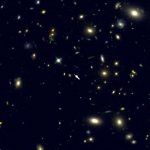W. M. Keck Observatory press release…
UCLA astronomers have used the W. M. Keck Observatory on Maunakea, Hawaii to make the first accurate measurement of the abundance of oxygen in a distant galaxy. Oxygen, the third-most abundant chemical element in the Universe, is created inside stars and released into interstellar gas when stars die. Quantifying the amount of oxygen is key to understanding how matter cycles in and out of galaxies. This research is published online in the Astrophysical Journal Letters.

Credit: Ryan Sandres and the CANDELS Team
Knowing the abundance of oxygen in the galaxy called COSMOS-1908 is an important stepping stone toward allowing astronomers to better understand the population of faint, distant galaxies observed when the Universe was only a few billion years old, Shapley said.
COSMOS-1908 contains approximately one billion stars. In contrast, the Milky Way contains approximately 100 billion stars. Furthermore, COSMOS-1908 contains approximately only 20 percent the abundance of oxygen that is observed in the Sun.
